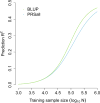Dissecting the genetics of complex traits using summary association statistics
- PMID: 27840428
- PMCID: PMC5449190
- DOI: 10.1038/nrg.2016.142
Dissecting the genetics of complex traits using summary association statistics
Abstract
During the past decade, genome-wide association studies (GWAS) have been used to successfully identify tens of thousands of genetic variants associated with complex traits and diseases. These studies have produced extensive repositories of genetic variation and trait measurements across large numbers of individuals, providing tremendous opportunities for further analyses. However, privacy concerns and other logistical considerations often limit access to individual-level genetic data, motivating the development of methods that analyse summary association statistics. Here, we review recent progress on statistical methods that leverage summary association data to gain insights into the genetic basis of complex traits and diseases.
Conflict of interest statement
No competing interests
Figures




References
-
- Evangelou E, Ioannidis JP. Meta-analysis methods for genome-wide association studies and beyond. Nat Rev Genet. 2013;14:379–389. - PubMed
-
- Han B, Eskin E. Random-effects model aimed at discovering associations in meta-analysis of genome-wide association studies. American journal of human genetics. 2011;88:586–598. This study introduced a powerful new random-effects meta-analysis method that employs a null model of no-heterogeneity. - PMC - PubMed
Publication types
MeSH terms
Grants and funding
LinkOut - more resources
Full Text Sources
Other Literature Sources
Miscellaneous

